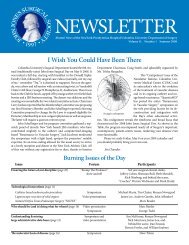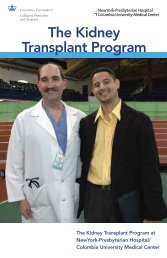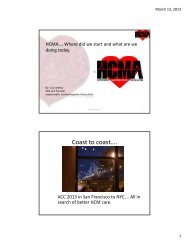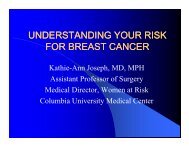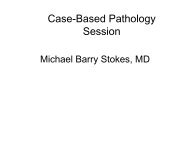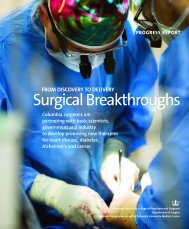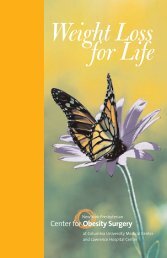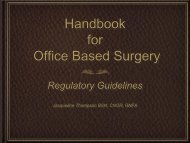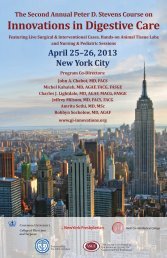NEWSLETTER - Columbia University Department of Surgery
NEWSLETTER - Columbia University Department of Surgery
NEWSLETTER - Columbia University Department of Surgery
Create successful ePaper yourself
Turn your PDF publications into a flip-book with our unique Google optimized e-Paper software.
<strong>of</strong> infants and tension-free palate repairs are difficult to achieve,<br />
<strong>of</strong>ten requiring dermal bolstering. Sam Rhee and <strong>Columbia</strong> anesthesiologist<br />
Imre Redai joined Aziz on his last trip in 2008 and coauthored<br />
his description <strong>of</strong> their combined experience.<br />
Bangladesh has 150 million people and only 29 oral-maxill<strong>of</strong>acial<br />
and plastic surgeons, with most <strong>of</strong> them huddled in its capital<br />
city, Dhaka. In third world countries, cleft patients <strong>of</strong>ten bear debilitating<br />
disfiguration and societal shunning well into adulthood with<br />
defects that would routinely be repaired in infancy and toddlerhood<br />
in the western world. In Bangladesh, it is not just the shortage <strong>of</strong><br />
skilled surgeons: a popular misconception holds that children with<br />
clefts are born to pregnant mothers who cut fish and vegetables on<br />
the night <strong>of</strong> a full moon. As a result, many mothers feel responsible<br />
for their child’s disfiguration, and <strong>of</strong>ten both mother and child are<br />
alienated by their own family.<br />
Aziz’s trips to Bangladesh were under the auspices <strong>of</strong> the Impact<br />
Foundation Bangladesh (IFB), a non-pr<strong>of</strong>it, non-government<br />
organization based in Dhaka. IFB has a floating hospital barge<br />
named “Jibon Tari,” or Bengali for “Boat <strong>of</strong> Life.” Although it looks<br />
rather permanently moored, Bangladesh is well suited for towing<br />
IFB’s Jibon Tari, a pontoon-based, triple decked hospital barge with its own<br />
generator, one operating room (with 3 operating tables), a 3-bed recovery room,<br />
a 12-bed ward, x-ray, and a clinical lab. It has mid ship access and an extendable<br />
tent capable <strong>of</strong> accommodating up to 150 ambulatory patients. 12<br />
river barges, as it is the low-lying delta for the Ganges (Pama), Brahmaputra,<br />
and Meghna Rivers that flow into the Bay <strong>of</strong> Bengal.<br />
Missionary medicine is sufficiently different from practice in the US<br />
that first time physician travelers should join an experienced group.<br />
He or she should focus on absorbing the local customs and allaying<br />
concerns patients may have about Western medicine. Bidirectional<br />
acculturation is essential for achieving mission work’s ultimate goal,<br />
which is the permanent establishment <strong>of</strong> equivalent local capability.<br />
Mia Talmor<br />
Mia Talmor, a graduate <strong>of</strong> Weill-Cornell Medical College, remained<br />
at the institution to complete her general and plastic surgery<br />
residencies, and joined its faculty in 2000. She is well known in New<br />
York’s trauma, intensivist, and plastic surgery communities and the<br />
current President <strong>of</strong> the New York Regional Society <strong>of</strong> Plastic Surgeons<br />
(NYRSPS). Last year, shortly after her election, she organized<br />
an NYRSPS team to do voluntary medical relief work in Haiti. Her<br />
observations <strong>of</strong> the volunteer process and the situation that she encountered<br />
in Haiti are excerpted here:<br />
On January 12, 2010, my operating schedule included a<br />
patient who was dissatisfied with her reconstructed breast not<br />
matching her natural one, so I tried again using a novel tech-<br />
John Jones Surgical Society Volume 13, Number 2 Winter 2010<br />
nique and was thinking that things went well, when I heard on<br />
the way home that a magnitude 7 earthquake had struck Haiti<br />
within miles <strong>of</strong> Port Au Prince, where the majority <strong>of</strong> the population<br />
resides. Early estimates were that hundreds <strong>of</strong> thousands<br />
were dead or injured, and millions had lost their homes. The<br />
television news later on that evening was flooded with images<br />
<strong>of</strong> unthinkable destruction. As the days went on and the media<br />
coverage continued, the pictures got worse and worse.<br />
Haiti is by far the poorest country in the Western hemisphere<br />
with a per capita income <strong>of</strong> approximately $1300 USD.<br />
Moreover it has the lowest doctor to patient and hospital bed<br />
to patient in the world. … I decided to volunteer my services.<br />
It was clear from the onset that plastic surgeons would be<br />
badly needed, both in the early stages <strong>of</strong> acute treatment as<br />
well as for reconstructive procedures in the future. As a double<br />
board-certified plastic surgeon with extensive trauma training,<br />
I felt that my skill set would be put to good use. The ASPS<br />
and ACS were collecting money and names. The Society <strong>of</strong><br />
Critical Care Medicine was warning that volunteers had to<br />
finance their own travel, have updated rubella, hepatitis, and<br />
typhoid immunizations, and bring personal medicines, food<br />
and camping equipment, but all three organizations were hesitant<br />
to send volunteers until the situation was more secure.<br />
I began to make preparations for travel when I received<br />
an e-mail from a NYRSPS colleague working in a hospital<br />
outside Port-au-Prince, who requested that I share his e-mail<br />
amongst our membership. He had arrived within three days<br />
<strong>of</strong> the disaster and found himself in a border hospital that had<br />
sustained little structural damage. As a result, 4,000 patients<br />
had been flown in (mostly by the US and Dominican military)<br />
for treatment. My colleague and some volunteer orthopedic<br />
surgeons had been performing over 40 operations a day and<br />
were badly in need <strong>of</strong> both help and supplies. Within 24 hours<br />
we received responses from over 60 <strong>of</strong> our members who were<br />
willing to volunteer their services. We established a schedule<br />
which provided continuous plastic surgical back-fill and care<br />
through late April. Past NYRSPS President Tracy Pfeiffer and<br />
I were the first to depart.<br />
We arranged for transportation to the hospital through<br />
Santo Domingo as the Port-au-Prince airport had been closed.<br />
The building was intact and housed five make-shift operating<br />
rooms, a recovery room, a make-shift “intensive care unit,” and<br />
a maternity ward. Patient wards were in make-shift tents surrounding<br />
the building and portable toilets were set up on the<br />
periphery. Hospital staff, all <strong>of</strong> whom were voluntary, set up<br />
tents outside the building. The State <strong>Department</strong>’s USAID had<br />
established portable headquarters in one wing <strong>of</strong> the building.<br />
Most <strong>of</strong> the acute trauma had been treated, and our work<br />
focused on wound care and closure. Nearly all <strong>of</strong> the patients<br />
had sustained at least a long bone injury, and many had been<br />
trapped beneath rubble for prolonged periods, delaying acute<br />
therapy. In the early aftermath <strong>of</strong> the earthquake, medical<br />
teams were working to stabilize these injuries in make-shift<br />
hospitals, without electricity, equipment, or medications, so<br />
most <strong>of</strong> the initial life-saving or limb-sparing procedures required<br />
revision surgery. Many patients had open amputations,<br />
unstable long bone fixations, and infected surgical wounds.<br />
Ours was a more stable environment, with antibiotics and<br />
equipment, but still on dirt floors, which caused us to avoid<br />
muscle flap procedures that are the mainstay <strong>of</strong> plastic sur-<br />
25



